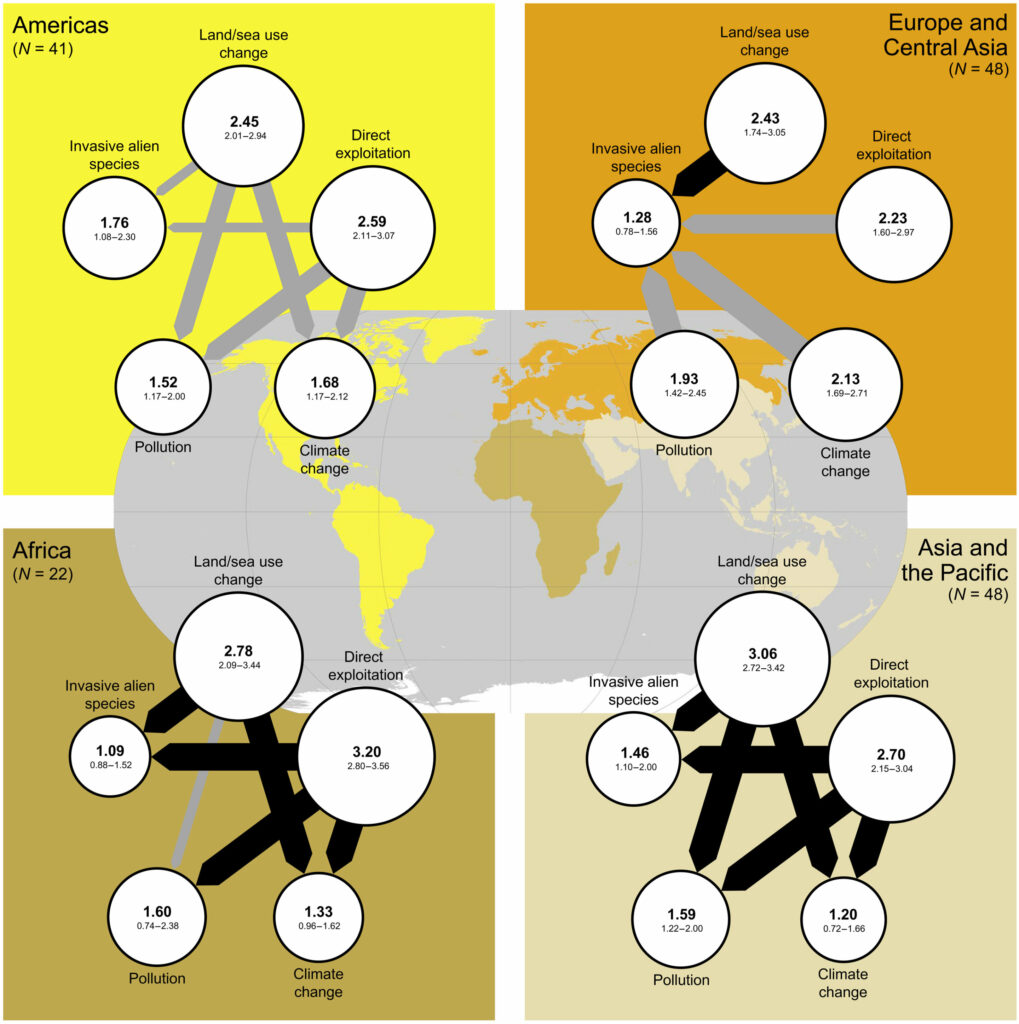New research into the causes of the devastating global biodiversity crisis has found that the conversion of natural forests and grasslands to intensive agriculture and livestock is the biggest cause
The next biggest drivers are the exploitation of wildlife though fishing, logging, trade and hunting – and then pollution.
Whilst climate change has rightly attracted attention for its catastrophic consequences for the natural world, it is only the fourth largest driver of biodiversity loss on land, followed by invasive alien species in fifth place. This major new study, published during the COP27 climate summit, demonstrates clearly that tackling global warming on its own will not be enough to stop the catastrophic decline of the world’s biodiversity, and with it our future.
Greenhouse gasses have been known to be the leading cause of the climate crisis for decades but just as important is understanding what is behind the enormous and rapid decline in species. A million species of animal and plant are threatened with extinction, while ecosystems worldwide are changing away from their natural condition which means that they may be less likely to meet humanity’s needs.
Professor Andy Purvis is a research lead at the Natural History Museum whose work focuses on biodiversity, and co-author of this new study published in Science Advances. He says: “The biodiversity crisis has to be taken seriously! Apart from things we mine, like fossil fuels, all our supply chains start in ecological systems. We all absolutely depend on these systems continuing to work reliably. There is not yet enough recognition that economies can’t grow sustainably by running nature down.”
The study’s authors, led by Dr Pedro Jaureguiberry of the Universidad Nacional de Córdoba in Argentina and Dr Nicolas Titeux of the Luxembourg Institute of Science and Technology, found climate change, whilst only fourth on land, was ranked second in terms of destruction of ocean biodiversity. Oceans have a different ranking to land and freshwater, with direct exploitation, mostly from fishing, coming first.
While for land-based environments climate change was only fourth biggest driver, the study’s authors suspect it will move up the rankings as the full effect of the crisis becomes more apparent over the coming years and decades.
Need for nature-based solutions
This major study should be a gamechanger for understanding how to tackle biodiversity loss. Dr Pedro Jaureguiberry says: “Our study brings comprehensive and rigorous information on which drivers cause the most damage to biodiversity at multiple levels, from regions and realms to the different facets of biodiversity, highlighting the importance of each driver in particular contexts. Hopefully, this will contribute to a more holistic approach to generate more efficient policies to reverse biodiversity loss.”
In particular, the research demonstrates the need for a more holistic approach that will tackle the twin threats of climate and the biodiversity crisis together. Dr Nicolas Titeux points out that, “The current global agreements such as the Convention on Biological Diversity and the UN Framework Convention on Climate Change can focus too narrowly on one driver, overlooking or, in the worst-case, undermining solutions for others”.
“Climate change and biodiversity loss have been tackled largely separately, by different policies that haven’t always considered the other problem. For example, biofuels are proposed as one way to get to net zero, but the expansion of plantations into natural forest that could result would be terrible for nature.”
Professor Andy Purvis explains

Image: Land/sea use change and direct exploitation are the main drivers in all regions. Area of the circle for each driver is proportional to its dominance score (indicated inside with 95% confidence interval; possible range = 0 to 4) within each IPBES region. Arrows linking pairs of drivers show the significance of the dominance difference between them based on bootstrapping: Arrow thickness reflects unadjusted P values (thin: P < 0.1, intermediate: P < 0.05, thick: P < 0.01, no arrow: P ≥ 0.1), and arrow shading reflects P values adjusted for multiple testing (black: P < 0.05, gray: P ≥ 0.05). N gives numbers of studies available for the analysis within each region. Credit: Science Advances (2022). DOI: 10.1126/sciadv.abm9982
The paper highlights some of the ‘nature-positive’ solutions that tackle both climate change and biodiversity loss such as large-scale restoration of natural forests and effective protection of coastal wetlands.
“I’d love for ‘nature-positive’ to get into the public consciousness as much as ‘net zero’ has. If future generations are going to have the same birth right we had of a liveable, supportive planet, then all parts of society will have to transition as quickly as possible to being both net zero and nature-positive.”
Professor Andy Purvis says
Read the paper: Science Advances
Article source: Natural History Museum
Image credit: Денис Пятков / Pixabay








